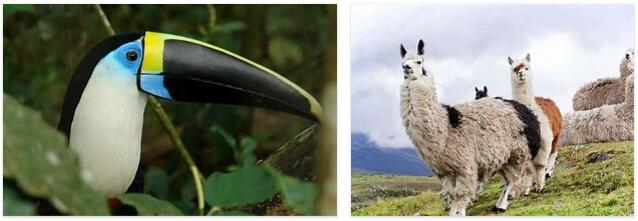Species-rich Ecuador
Ecuador is one of the 17 countries in the world, in which together 70 percent of all species in the world can be found. It’s called a mega-diversity country. The different landscapes of coast, mountains, rivers and rainforest offer a habitat for many animals and plants. The coastal region and the Galápagos Islands are also among the regions of the world with a particularly large number of endemic plants and animals: species that only live here.
To protect its nature, Ecuador has set up 11 national parks and a number of protected zones. This is very important because, like everywhere in countries with tropical rainforests, they are threatened by deforestation. The mangrove forests, however, are threatened by shrimp farming. To get more information on Ecuador and South America, check diseaseslearning.
Animals: Who lives there in Ecuador?
The diverse landscapes of Ecuador are the habitat of many animal species. The rare mountain tapir can be found in the Andes. He only lives in Colombia and Ecuador. A woolly fur protects it against the cold.
The Andean jackal is also native here. Unfortunately he is hunted for his pretty red-gray fur. Another Andean inhabitant is the spectacled bear. And who cannot be missing in the Andes? The lama!
The lama
Did you know llamas are camels? In contrast to the camels in Africa and Asia, the South American camels have no humps. Llamas descend from the guanaco and are kept as pets. They still serve as pack animals, especially in the Andes.
There is also the vicuna, also a camel from South America. The alpaca was also tamed as a pet. Its wool is processed.
From agouti to peccary
Pakas, capybaras and agoutis are rodents of the country. The approximately 380 species of mammals also include sloths, anteaters, armadillos and peccaries (umbilical pigs). Predators that live here include the jaguar, puma, jaguarundi, ocelot, tiger cat, long-tailed cat, Amazon skunk, crab raccoon and coati. Coat howler monkeys, capuchin monkeys and brown-headed spider monkeys can be found in the trees.
Flying residents
There are 1600 species of birds in Ecuador. Ecuador bears the Andean condor in its coat of arms. It has a wingspan of up to three meters. He belongs to the vultures and eats carrion. Its existence is at risk. The striped caracara also lives in the Andes. The Andean cliff bird is particularly striking with its orange-red plumage. The parrots and toucans are also colorful. Hummingbirds are native to 120 species! The shorebirds of Ecuador include the blue-footed boobies, which actually have blue feet.
In mangroves and rivers
The mangroves of the coast offer shelter for the American crocodile and the South American otter. Horned warblers, forest storks, frigate birds and marble herons also feel at home here. In the rivers of the Amazon basin, on the other hand, you can find the red piranha, the Amazon dolphin and the crocodile caiman.
In the Galápagos Islands
On the other hand, there are only a few species on the Galápagos Islands, but most of them are endemic. They include the Galápagos giant tortoises, marine iguanas, land iguanas and sea lions. Darwin’s finches are also famous. These songbirds are found only in the Galápagos Islands (apart from one species on Coconut Island, which belongs to Costa Rica) and were named after Charles Darwin.
The 14 species of Darwin’s finches all descend from an ancestor who once came to the islands. This first species spread to one of the islands because there were no enemies and they found plenty of food and space. But they then multiplied so much that some moved to other islands. There they developed differently because there was different food. Today’s species mainly differ in the shape of their beaks. Species with a strong, thick bill crack strong seeds, while others prefer insects. A total of 38 endemic bird species live on the Galápagos Islands.
Darwin and his finches
Charles Darwin was a British naturalist. After many research trips he designed the foundations of the theory of evolution. In it he explained why and how different species form. Living things with better traits for survival keep multiplying. This is called natural selection. In 1835 he came to the Galápagos Islands and brought the birds with him, which were then called Darwin’s finches after him.
What is growing there in Ecuador?
Together with Colombia, Ecuador is the only country that has tropical rainforests on the Pacific coast. The plants that grow here are different from those in the Andes and again different from those in the lowlands of the Amazon basin (Oriente). Mangroves also grow on the coast, which in turn attract certain animals. A total of 17,000 plant species grow in Ecuador.
On the coast
In the tropical rainforest of the northern coastal region and the Amazon basin in the east, dense trees grow, on which lianas and orchids or bromeliads settle again. In the southern coastal area, which is drier, dry forest grows. It sheds its leaves in the dry season. One of the largest trees here is the kapok tree. It grows up to 70 meters!
In the Andes
In the Andes, the Páramos offer a very special vegetation. These landscapes are located in the mountains from around 3000 meters altitude and are humid and cool. Mainly grasses and small shrubs such as Espeletia species and other rosette plants grow here.
The puya plants are also typical. From their rosettes a high inflorescence grows in the middle – but only after many years. Many endemic species can be found in Ecuador, for example Puya angelensis.
The shrubs of the streptosoles are scaly hairy. They grow at an altitude of 1200 to 2500 meters. The Polylepis trees are also found in the Andes. You can recognize them by their peeling, reddish bark. Because their wood is used as firewood or construction wood, the Polylepis forests are in danger.
